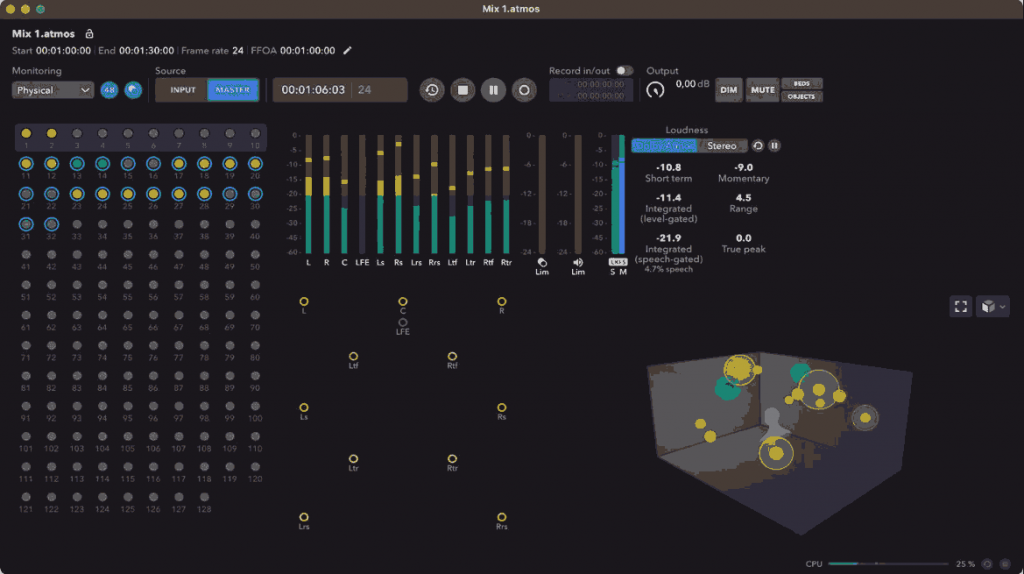In the ever-evolving landscape of audio technology, Dolby Atmos has emerged as a groundbreaking innovation that redefines the way we experience sound. Dolby Atmos rendering is a pivotal aspect of this technology, enabling a three-dimensional audio experience that immerses listeners in a world of sound like never before.
In this blog post, we’ll delve into Dolby Atmos rendering, uncovering its principles, benefits, and impact on various industries.
Understanding Dolby Atmos Rendering
Rendering refers to the process of taking audio content that has been mixed with object-based metadata and transforming it into the final audio output for playback on a specific audio system.
At its core, Dolby Atmos rendering is a sophisticated audio processing technique that allows content creators to position sound elements in a 3D space, making the audio environment more dynamic and realistic. Unlike traditional stereo or surround sound setups, where sounds are confined to fixed channels, Dolby Atmos enables sound objects to move freely in a three-dimensional space. This creates a sense of height, depth, and dimensionality that closely mimics real-world auditory experiences.
Key Principles of Dolby Atmos Rendering
- Object-Based Audio: In Dolby Atmos, the sound is treated as an independent object rather than being bound to specific channels. Each sound object can be precisely positioned in a 3D space, including overhead, around, and even below the listener, resulting in a truly immersive sonic experience.
- Spatial Audio: Dolby Atmos rendering takes advantage of height channels to create an enveloping audio environment. This allows for sounds to originate from above, enhancing the realism and immersion of the audio experience.
- Audio Panning and Movement: Dolby Atmos rendering provides seamless audio panning and movement. Sound objects can move smoothly from one point to another in the 3D space, making the listening experience incredibly lifelike.
- Room Acoustics Adaptation: Dolby Atmos rendering can adapt to various room acoustics, ensuring that the audio experience remains consistent regardless of the listening environment. This adaptability contributes to a more personalized and high-quality auditory journey.
Benefits of Dolby Atmos
- Immersive Entertainment – Dolby Atmos is revolutionizing the entertainment industry by offering a heightened level of immersion in movies, TV shows, and video games. Viewers and gamers are no longer mere spectators; they are part of the action, surrounded by sounds that originate from every direction.
- Music Reinvented – The music industry is also leveraging Dolby Atmos rendering to provide listeners with an entirely new way to experience their favorite tunes. Artists and producers can experiment with sound placement, creating multi-dimensional music that feels like a live performance.
- Enhanced realism in Virtual Reality – For virtual reality (VR) experiences, accurate audio rendering is crucial to the overall sense of presence. Dolby Atmos can contribute to more convincing VR environments by accurately reproducing sounds as they would occur in the real world.
- Gaming leaps – Gamers are embracing Dolby Atmos for its potential to enhance gameplay. Imagine hearing footsteps approaching from behind, helicopters flying overhead, and explosions resonating all around you – this level of sonic detail can significantly improve gaming performance and immersion.
Implementation Challenges and Future Prospects
While Dolby Atmos rendering brings an array of benefits, its implementation requires careful consideration of hardware, software, and content creation techniques. Not all audio equipment and setups are compatible with Dolby Atmos, and content creators must adhere to specific guidelines to optimize the listening experience across various devices.
Venera Technologies offers automated quality control and verification checks for audio content mixed in Dolby Atmos. This ensures that the content adheres to Dolby Atmos specifications and standards, minimizing errors and issues during the rendering process.
Venera’s QC solutions, Quasar® & Pulsar, Automated audio/video file QC solutions, can also integrate with existing post-production, broadcast, and OTT workflows, making it easier for professionals to efficiently validate Dolby Atmos content in their workflow before delivering or at ingest. On top of this, Quasar® is a native cloud QC solution, allowing for collaboration and review of Dolby Atmos content across different locations, simplifying the workflow for remote teams.
Final Words
Dolby Atmos has ushered in a new era of audio experiences that captivate your senses and immerse you in a world of sound like never before. By embracing object-based audio, spatial audio, and adaptive room acoustics, Dolby Atmos has transformed entertainment, music, gaming, and even virtual reality.
While challenges exist in terms of implementation and compatibility, the potential of the technology is immense. As technology progresses, it’s exciting to see how Dolby Atmos becomes prevalent, enriching user experience with its unparalleled auditory accuracy. So, whether you’re watching a movie, enjoying your favorite song, or delving into a virtual realm, Dolby Atmos promises to be your gateway to a truly immersive sonic adventure.
Follow Techdee for more!
